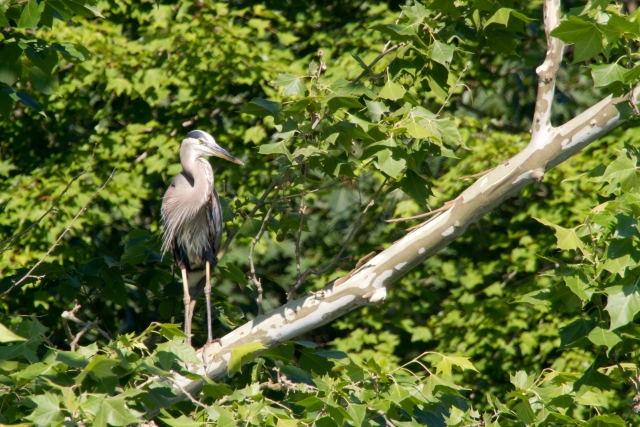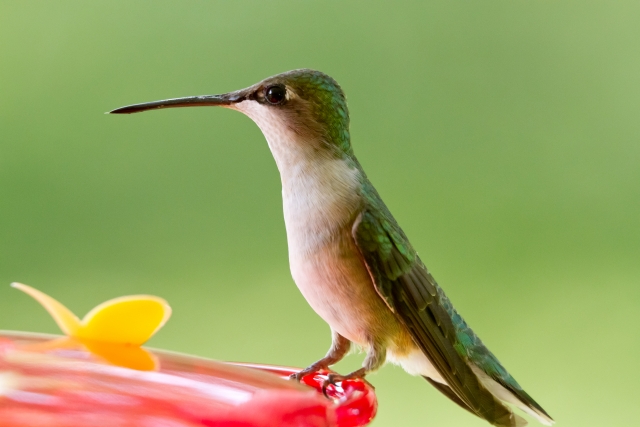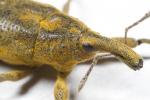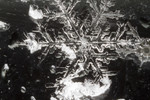Reply to comment
Two Birds with one Lens
ktuli — Tue, 07/22/2014 - 19:43
Well, so much for getting back to a more regular posting schedule...
I did manage to setup Tom's 100-400mm lens recently and got some decent bird photos. These are probably some of the best bird photos I've managed to date, so without any further ado I give you a pretty large bird and a fairly tiny bird, both shot with the same lens but in very different methods.
First up we have a Great Blue Heron (Ardea herodias) - we have these visit our pond with some regularity, but they still remain skittish and any attempt to approach them has proven difficult. This shot I managed from our front porch - I'd thought I used both a 2x and a 1.4x teleconverter on it, but the EXIF info is reporting only the 2x numbers, so I could be mistaken. One interesting thing here is that supposedly I shouldn't have been able to use autofocus for this shot, but I did. The Canon 7D (and most cameras) can only use autofocus is the maximum aperture value is larger than f/5.6. With this lens and any teleconverter, the effective maximum aperture is well above that mark (since the lens itself is f/5.6 and the teleconverters reduce that by 1, 2, or 3 stops if combined). However, putting the camera into live view and using the LCD to zoom in on my subject, I was then able to use AF without any issues at all. I'm sure the results aren't ideal - and that is evident if you look at this image at full size, but it certain had usable results here.
Technical Data: Canon EOS 7D, Canon EF 100-400mm f/4.5-5.6L IS USM (borrowed) at 400 with Canon EF 2x and 1.4x Telephoto Extender II, 1/640 sec at f/11. IS On. ISO 640. RAW conversion in Adobe Camera Raw.
This next one takes that same telephoto lens and uses it in a very different method. Instead of using teleconverters to extend its long distance capabilities, I instead used an extension tube to improve its close distance capabilities. I know the terms are confusing, but perhaps some day I'll write up the differences of teleconverters versus extension tubes, but for now just a quick explanation. Teleconverters are used to magnify the image, they usually come in 2x and 1.4x magnifications; their trade-off is that they reduce the amount of light coming into the camera and effectively make exposure more difficult. Extension Tubes are used to reduce the minimum focusing distance of a lens and by doing so provide a smaller degree of magnification; their trade-off is that they eliminate the lens' ability to focus on items farther away, but they do not affect the amount of light entering the camera.
Anyway, I used the Canon 100-400mm lens with a 32mm extension tube to allow for the lens to focus closer and provide a bit of magnification and pointed it at the hummingbird feeder on our porch. With patience, I managed to get a handful of shots using different methods - I'll share one today and a couple more soon.
Technical Data: Canon EOS 7D, Canon EF 100-400mm f/4.5-5.6L IS USM (borrowed) at 400 with Kenko DG Auto Extension Tube (32mm), 1/400 sec at f/5.6. IS On. ISO 1600. RAW conversion in Adobe Camera Raw.
As you can see, these are slowly improving. I'm happy to be able to start seeing the detail of individual feathers. I'll have to continue working on getting better results, but this is a nice step in the right direction.
- Bill





